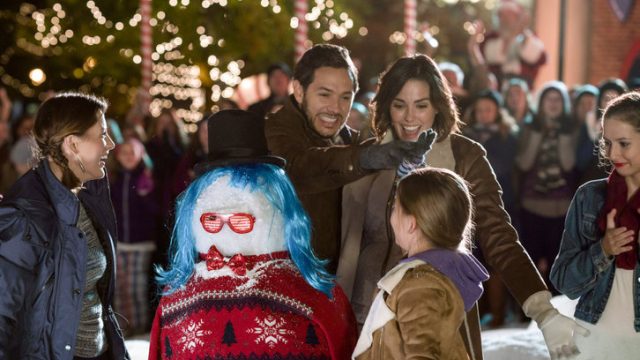Starting in November, the Hallmark Channel puts on two straight months of Christmas movies, 20 hours a day, 7 days a week (from 7-11, they run Home and Family, a morning talk show of sorts). None of these movies make it into movie theaters, but Hallmark premieres something like 19 holiday themed movies during the course of this season each year. They may not have gigantic budgets, but these movies represent a decent portion of the Hollywood industry, providing work to working professionals.
There are three aspects to these Hallmark movies: work/business, love, and family. Usually, these movies focus on a main character longing for family in the face of pressures from work or business, and having to find love through the issues of strife. Sometimes the movies reject the principle of women going to work, and sometimes it supports it, but the primary thrust is that everybody needs to fall in love and create a nuclear family for their own happiness.
In 2015’s Family For Christmas, Lacey Chabert is a successful investigative journalist longing for love and family. After making a wish to a party Santa, she swaps to an alternate reality where she is Molly Homemaker married to her long lost love, with the brattiest children in the world, and is forced to decide between her career and a family. But, in 2016’s A Wish For Christmas, Lacey Chabert is a lowly graphic designer whose manager steals all her ideas until she wishes for confidence. Then she has to win the heart of her Christmas hating boss. They have to deliver a business pitch in the boss’ home town, where we find out his family loves Christmas, and the only reason the boss hates Christmas is because his father sent an ultimatum at some point demanding the boss dissolve his big city company to join with the successful small town family business.
These are largely monocultural affairs, with few people of color even among the supporting characters. And, forget about queer sexuality. It’s not that these movies are actively against the quilt bag, but they just choose to ignore anybody who isn’t white and hetero (browsing through the 2016 sneak preview, the darkest skin tone belonged to Michael Rady), unless they’re Mariah Carey. (Contrarily, systemically shutting out whole demographics is actively racist)
It’s 2016, people. It’s not like casting Tia or Tamera Mowry instead of Candace Cameron Bure or Bill Bellamy instead of Brandon Routh would suddenly completely change every aspect of the movie. Herein lies a major problem exposed this year. As our media becomes hyper-segmented, we increasingly find ourselves in an echo chamber of our own making. I’m guilty of doing it myself; this week I rented four campy trash movies rather than going for something multi-cultural (Judge Reinhold’s mustache in Zandalee is the most exotic element on the covers).
15 years ago, one of my professors hinted at this effect. He said he normally has the channel tuned to Comedy Central, which he said focuses on the sarcastic and sardonic, basically marketed for people exactly like him. We need executives to break channels out of their normal, and we as consumers should venture out of our comfort zones. I’m not advocating that every channel needs to have shows like Sense8 (though that was my favorite series to come out of Netflix), but we can do much better.

